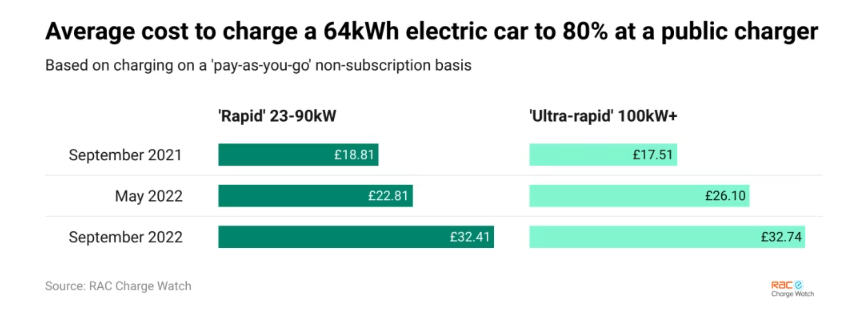September’s edition of our monthly ‘Electric Vehicle & Alternative Drivetrain News Roundup’ features a mixed bag of positive and not so positive news, as Toyota, Honda, Nissan, Greenpeace, the RAC and NASA made the headlines.
Manufacturers and the consumers alike are starting to feel the effects of the global recession – we suspect that as the market conditions continue to worsen so will the influx of bad news; it is without question a testing time for the industry.
Toyota, Honda, Nissan are lagging behind their competitors in decarbonisation efforts – Greenpeace
Japanese car manufacturers Toyota, Honda and Nissan have faced criticism after ranking at the bottom of a Greenpeace study which assessed ten automakers’ decarbonisation efforts. The ranking measured how much progress the manufacturers have made in phasing out internal-combustion engines and successfully decarbonising their supply chains.
| Rank | Company | Overall Score (Out of 100) | 2021 ZEV sales % |
| 1 | General Motors | 38.5 | 8.18% |
| 2 | Mercedes-Benz | 37.0 | 3.82% |
| 3 | Volkswagen | 33.0 | 5.21% |
| 4 | Ford | 23.5 | 1.40% |
| 5 | Hyundai-Kia | 22.3 | 3.49% |
| 6 | Renault | 20.3 | 6.69% |
| 7 | Stellantis | 19.3 | 2.86% |
| 8 | Nissan | 13.4 | 2.20% |
| 9 | Honda | 12.8 | 0.35% |
| 10 | Toyota | 10.0 | 0.18% |
The study found that zero-emission vehicles failed to account for 1% of Toyota and Honda’s total vehicle sales in 2021. To put this into context, 499 out of every 500 vehicles that Toyota sold were powered by fossil fuels. Greenpeace attributed their poor EV sales to underdeveloped supply chains and their decision to prioritise hybrid models over their fully electric counterparts.
“The time for hybrids, I think, has finished… fundamentally, when compared to other global automakers, they’re (Toyota and Honda) falling far behind.” – Daniel Read, climate and energy campaigner at Greenpeace Japan.
Greenpeace have also heavily criticised Honda for having a distinct lack of a progressive roadmap to achieve its own long-term decarbonisation targets. It is unclear as to how they are going to make, for example, zero-emission vehicles and fuel cell electric vehicles account for 100% of new sales in order to achieve carbon neutrality by 2050.
“There is a lot of hype around electric vehicles right now, but the reality on the ground is that traditional automakers are not doing nearly enough to transition to zero-emission vehicles,” said Greenpeace East Asia Project Lead Ada Kong.
There was some positive news for both Mercedes-Benz and Ford as their rankings jumped five and four places in the rankings respectively.
Cost of charging an electric vehicle nearing the price of petrol after a 42% surge in cost
Figures published by the RAC have revealed that the cost of charging an electric vehicle using public charging points on a pay-as-you-go, non-subscription basis in the UK has risen by 42% over the past four months. This surge has resulted in electric vehicle owners paying on average 18p per mile for electricity, compared to 19p per mile for petrol and 21p per mile for diesel when charging in public.
It now costs around £32.41 to rapid charge a typical family-sized electric car with a 64kWh battery to 80% using a public charging point, which is up nearly £10 since May 2022. Drivers who rely on public charging are affected by this price rise the most, particularly when compared to the charging rates from home.
Comparatively, when charging an average-sized EV from home under the recently enacted Energy Price Guarantee, the cost per mile is around 9p. The cost to charge an electric vehicle to 80% at home would therefore be under £18 at the current rates – almost half the price of charging through a public charging point.

RAC spokesman Simon Williams weighed in on the situation: “It remains the case that charging away from home costs less than refuelling a petrol or diesel car, but these figures show that the gap is narrowing as a result of the enormous increases in the cost of electricity. These figures very clearly show that it’s drivers who use public rapid and ultra-rapid chargers the most who are being hit the hardest.”
There are concerns that the high public charging prices may act as a deterrent to adoption for those looking to buy an electric vehicle. The RAC have called upon the government to adhere to the FairChange campaign’s call for the VAT rate for public charging to be reduced from 20% to 5% so that they are more in line with home charging prices.
Industry leaders in Germany believe that these soaring energy prices could, in a worse case scenario, threaten the future of electric vehicles. Rising electricity prices hurt both the consumer and manufacturer, and this has been compounded by increasing raw material costs, part shortages, and a reduction in disposable income worldwide as major economies enter recession.
NASA technology could reduce EV charging times to under five minutes
Researchers have discovered that NASA technology currently used on the International Space Station may be applied to EV chargers to reduce charging times to a maximum of five minutes.
A significant improvement on the industry leading twenty minute-plus charging times that fast-chargers currently offer.
NASA has developed a complex cooling system known as ‘subcooled flow boiling,’ which stops chargers from overheating at higher currents. The technology achieves this by pumping a dielectric (non-electrically conducting) liquid coolant through the cable during charging, allowing for a quicker flow of electricity without compromising the integrity of the charger through overheating.
Through subcooled flow boiling, a charger can deliver 4.6 times the current of the fastest available electric vehicle chargers on the market today by removing up to 24.22 kilowatts of heat. This heat reduction enables the charger to provide up to 2,400 amperes (unit of electrical current), which is far beyond the 1,400 amperes required to reduce time required to charge an electric car to five minutes. Fast-chargers only deliver currents up to 520 amperes and most chargers available to consumers (primarily home chargers) only support currents of less than 150 amperes.
NASA stated: “Application of this new technology resulted in unprecedented reduction of the time required to charge a vehicle and may remove one of the key barriers to worldwide adoption of electric vehicles.”
Frequently Asked Questions
At the time of writing (September 2022) public charging points cost on average 18p per mile. So a Tesla Model 3 (2022) with a maximum range of 360 miles on a single charge would cost £64.80.
Toyota. In 2021 electric vehicles accounted for 0.18% of their total vehicle sales.







